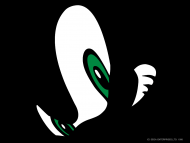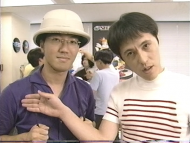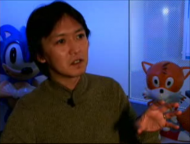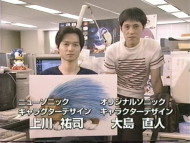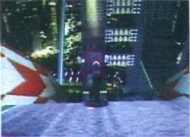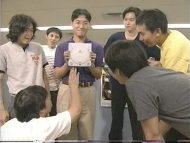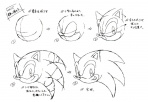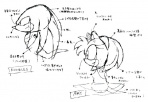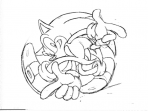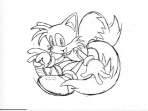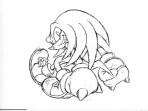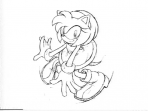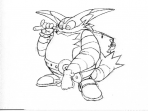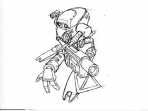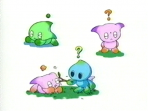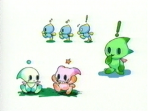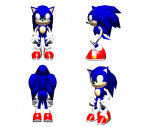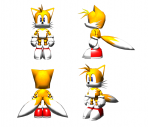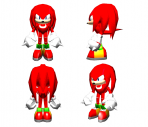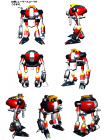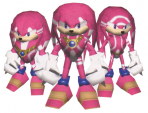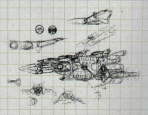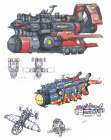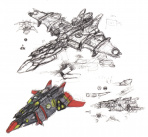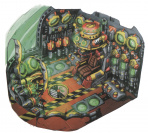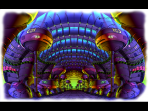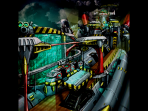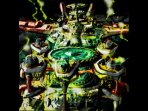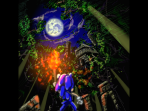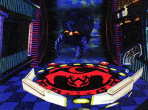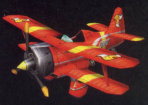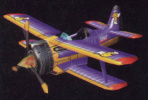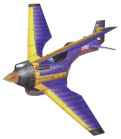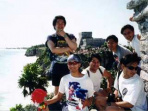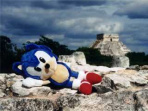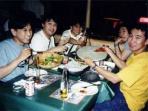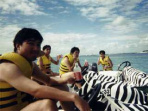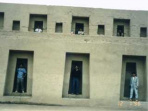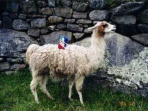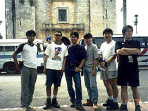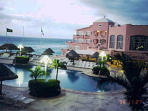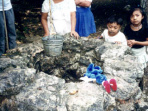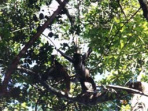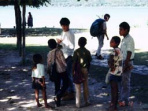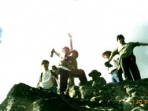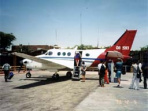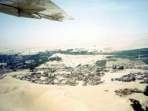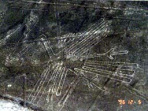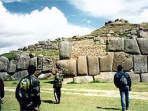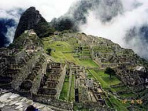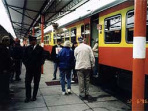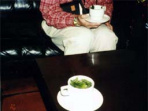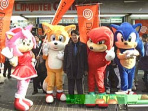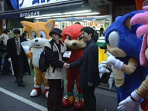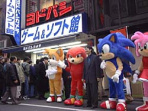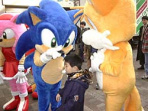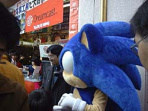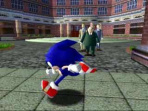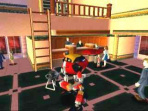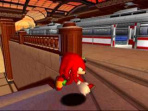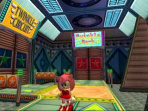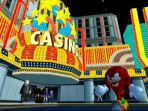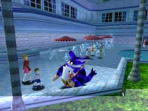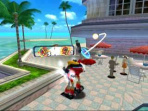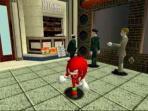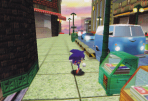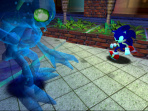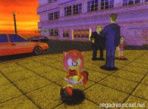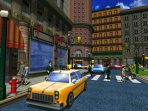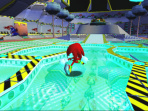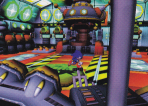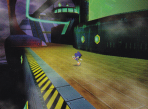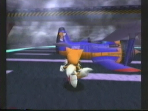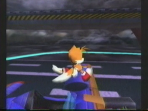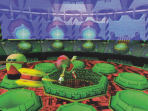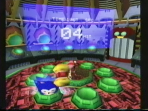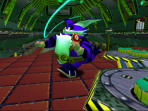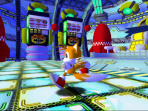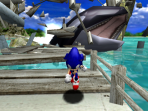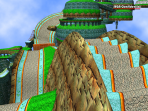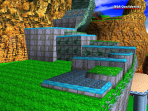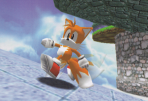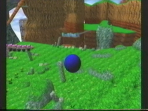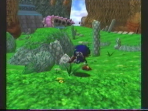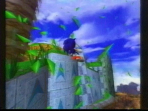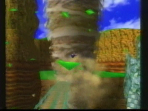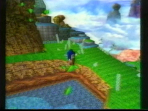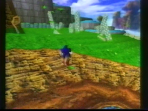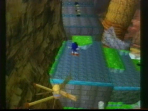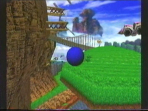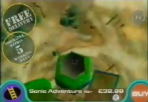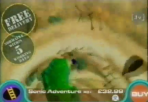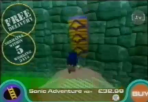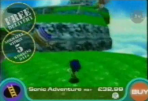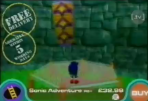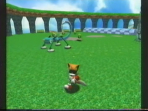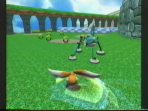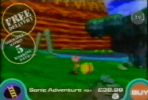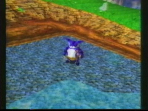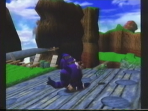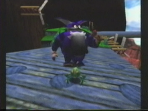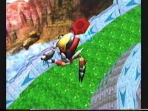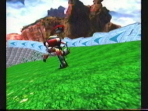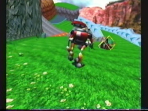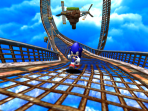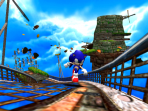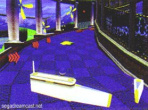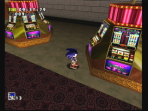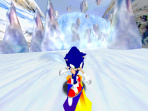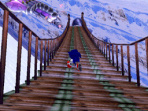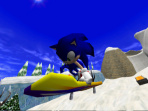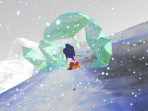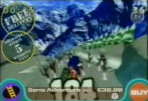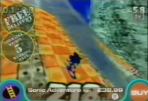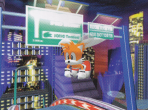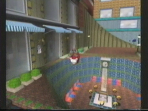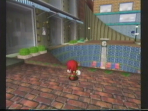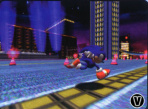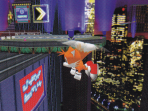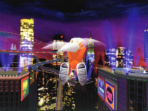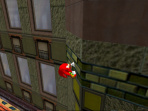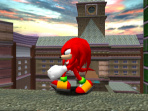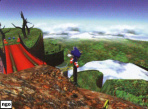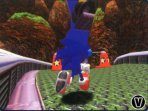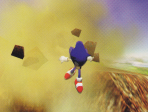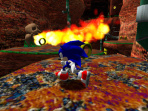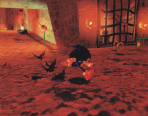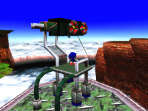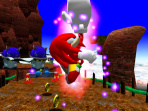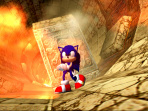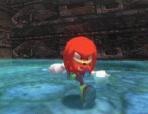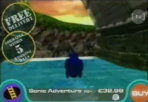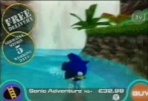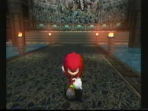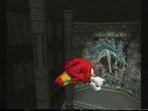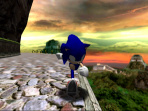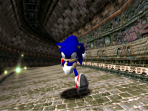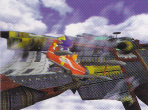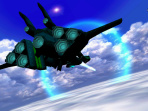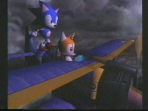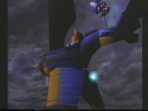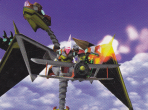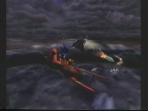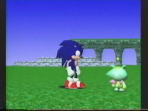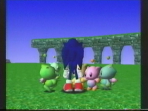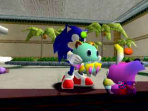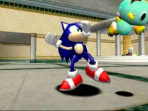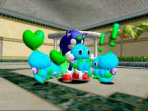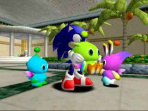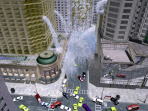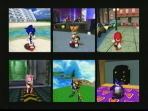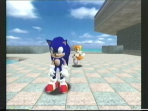Difference between revisions of "Sonic Adventure/Development"
From Sonic Retro
RGamer2009 (talk | contribs) (→Sonic Team Story) |
(I had to shave it.) |
||
| Line 1: | Line 1: | ||
| − | + | ''[[Sonic Adventure]]'' went through many ideas and changes during the development process. What follows is a collection of items related to the game's development. | |
| − | |||
| − | == | + | ==Development Process== |
| − | The | + | [[File:Sonic1024.png|thumb|190px|The now iconic silhouette of Sonic, green eyes and grin foreshadowing his jump into a 3D world.]] |
| − | + | With the completion of ''[[Sonic & Knuckles]]'', the majority of the Japanese side of the [[Sega Technical Institute]], including producer and programmer [[Yuji Naka]], decided to return to their native land, leaving behind the ''[[Games featuring Sonic the Hedgehog|Sonic the Hedgehog ]]'' franchise in the hands of other creative teams in other countries. Once back in Japan, Naka finally reunited with the original creator of [[Sonic the Hedgehog]], [[Naoto Ohshima]]. Resurrecting the [[Sonic Team]] name, a group of both veteran members and newcomers decided to begin work on a title completely separate from the Sonic concept, wanting to prove that the minds behind the biggest franchise in Sega's catalogue were able to create new and exciting ideas without completely relying on the most famous hedgehog in the world. With the [[sega:Sega Saturn|Sega Saturn]] hardware well on its way to being released for the consumer market, the team began development on an idea Naka had conceived right after the completion of ''[[Sonic the Hedgehog 2 (16-bit)|Sonic the Hedgehog 2]]'' - ''[[sega:NiGHTS Into Dreams|NiGHTS Into Dreams]]''. | |
| − | |||
| − | + | Knowing that the Sonic franchise was still a viable money-making tool, Sega was unwilling to let the series slumber, assigning the members of STI that remained to work on the next major installment of the series: ''[[Sonic X-treme]]''. Though filled with people who had grand visions of what Sonic would be like in the third dimension, the project would be almost doomed from the start. With Naka viewing the very first conceptual ideas for the game, the man who would become the head of Sonic Team simply shook his head, saying "good luck" and moving on. Indeed, through numerous shifts and changes in both hardware and the director, the project ultimately would be canceled, leaving a hole in the Saturn lineup that would be felt across the board at Sega. While other titles such as the [[sega:Traveler's Tales|Traveler's Tales]]-produced ''[[Sonic 3D: Flickies' Island]]'' and the [[sega:Sega 32X|Sega 32X]] exclusive title ''[[Knuckles Chaotix|Chaotix]]'' attempted to fill the void left by ''X-treme'', it was clear that these titles would not be the heavy-hitters the company needed. To the outside world, it seemed clear that the only people who would be able to make Sonic work in the new generation of gaming would be the people responsible for helping launch the franchise in the first place - Sonic Team. | |
| − | + | [[File:Naka Ohshima Hanging Out.png|thumb|190px|Naka and Ohshima - together again.]] | |
| + | Though it is possible Naka and Ohshima were quite aware that they would have to produce another Sonic title at some point, it was [[Takashi Iizuka]], Senior Game Designer for ''[[Sonic the Hedgehog 3]]'' and ''Sonic & Knuckles'' who began pushing the idea of a "Sonic RPG" to be the development studio's next big game. Though work on Sonic Team's second non-Sonic property ''[[sega:Burning Rangers|Burning Rangers]]'' was underway, it was decided that the group would indeed look into producing the next big Sonic game. Realizing that the majority of the team responsible for the classic games was still under Sega's employment, Iizuka made it a point to discuss with each person what made up Sonic, not just as a compelling character but as a compelling game series, not wanting to lose those essential elements in the jump to 3D. | ||
| − | + | Not wanting to strictly make an RPG, but knowing that 3D-capable systems offered both the space and graphical capability to expand on a story, it was decided that the game would have a much greater emphasis on plot, just as ''[[Sonic 3 & Knuckles]]'' had taken a narrative leap over its predecessor, ''Sonic the Hedgehog 2''. However, before any work was to be done on such specific details, the team knew they first had to figure out how to take Sonic and make him work outside of a two-dimensional plane. Arguing over just how Sonic would work, eventually a group consensus was reached as to how a 3D Sonic level would operate. Working with the basic building blocks, a simple test level was put together to see if what they had on paper would work in practice. | |
| − | |||
| − | {| | + | {{quote|1=When we built our first test level, we knew we had to test it out, just to make sure our ideas worked. It ended up only lasting about ten seconds, and we knew we couldn't build a game around this structure. We had to rebuild levels over and over again until we finally had a level length we were happy with.|2=Takashi Iizuka, Director of ''Sonic Adventure''}} |
| − | |||
| − | |||
| − | |||
| − | |||
| − | |||
| − | |||
| − | |||
| − | |||
| − | |||
| − | |||
| − | |||
| − | |||
| − | |||
| − | |||
| − | |||
| − | |||
| − | |||
| − | |||
| − | |||
| − | |||
| − | |||
| − | |||
| − | |||
| − | |||
| − | |||
| − | ===Character | + | [[File:Takashi Iizuka Sonic Adventure Interview.png|thumb|190px|Takashi Iizuka, Director of ''Sonic Adventure''.]] |
| − | <gallery widths=" | + | The earliest builds of the game were originally programmed with the Saturn in mind, as it was the current console the company was pushing and the focus of the rest of Sonic Team's development. However, when it became painfully obvious that the life span of the Sega Saturn was going to be dramatically shorter than the [[sega:Sega Mega Drive|Mega Drive]], the team reached a crossroads - either continue working on what would become ''Sonic Adventure'' as a Saturn title, or to scrap what they had done and begin working anew using the proposed specs of Sega's next system, codenamed "Katana." Realizing the futility of continuing with the Saturn, and knowing the scope of the project might be better suited for more advanced hardware, what could be ported was done so, the team now working on a game that would be one of the premier titles for the [[sega:Sega Dreamcast|Sega Dreamcast]]. Wanting to make sure the game would be the perfect demonstration of what the system would be capable of, Yuji Naka became involved in the hardware creation of the Dreamcast, offering suggestions and changes to the schematics of Sega's last great hope. |
| − | + | ||
| − | + | Not wanting to let the work that had been done for the Saturn version go to waste, the earliest builds of ''Sonic Adventure'' were transformed into the [[Sonic World]] portion of the compilation title ''[[Sonic Jam]]''. Intended to simply be a collection of the main four Mega Drive titles and an assortment of bonus features, this early look into how a 3D Sonic title would work was included, becoming the portal to a wealth of knowledge involving the blue blur. Unknowingly, the gaming public was used as a test subject to see how people would react to such a title. | |
| − | + | ||
| − | + | [[File:Ohshima Uekawa Hedgehog.png|thumb|190px|Ohshima, Uekawa, and a blue hedgehog.]] | |
| − | + | With production now in full gear for the Dreamcast, the production team wanted to take full advantage of the superior graphical capabilities they now had. Fueled with the desire to create worlds far more realistic than what had been possible beforehand, the core members of the ''Sonic Adventure'' development team, including Naka, Ohshima, and Iizuka, went on a trip to Central and South America. Although ruins and jungles had been used before in previous Sonic titles, none of the team members had actually gone to any such locales in person before, instead taking their inspiration from movies, tv shows, and other popular media. With this in mind, it was decided the team would explore on their own, in the hopes that this change in scenery would provide a wealth of inspiration for the game. Starting out in the Yucatan Peninsula of Mexico, the group traveled through Chichen Itza, Cancun, Tulum, and Tikal, then flew down to the South American country Peru, where they visited Cuzco, Mache Picchu and Ica. | |
| − | + | ||
| − | + | Confronted with sights and sounds they had never seen before, the team made sure to not let the environment overwhelm them, knowing the trip was not simply a pleasure cruise. Filming their trip and taking pictures of everything in sight, many of their images were then used in the creation of such locations as [[Emerald Coast]], [[Lost World]] and the [[Mystic Ruins]], not just as inspiration but in some cases literally. Many of the textures found in the more realistic areas of the game were lifted straight from the team's collected photographs. One idea for the game which hadn't been part of the original plan, but was directly inspired by their trip, was the [[Sand Hill]] level in [[Miles "Tails" Prower]]'s version of the game: | |
| + | |||
| + | {{quote|1=While we were in Peru...we noticed some people boarding on sand dunes. We were so impressed with this. We had no idea this kind of sport actually existed. It was so new and exciting for us to see this, we knew that we had to add this element to our game. And we figured that Tails, if anyone, was the most appropriate character to use.|2=Takashi Iizuka, Director of '"Sonic Adventure''}} | ||
| + | |||
| + | [[File:Hikenai.jpg|thumb|190px|Yuji Naka pretending to jam.]] | ||
| + | However, the trip was not all fun and games, the team having unexpected encounters with giant spiders, snakes, and reportedly Yuji Naka becoming ill at one point. At the end of it all, the team returned to Japan in one piece, full of enthusiasm to create the game. | ||
| + | |||
| + | Along with the idea of making a larger emphasis on story and creating more realistic worlds for Sonic to explore, it was decided that, to truly make this shine out on the market and showcase that it wasn't just a new Sonic game, but a kind of game that had yet to hit the market, it was decided that the principle cast would be redesigned, marking the start of a new era. [[Yuji Uekawa]], who had previously created the title character of ''[[sega:Ristar|Ristar]]'' and worked on ''Flickes' Island'' and ''[[Sonic R]]'', was recruited to redraw characters that had imprinted into the minds of numerous people in the 90's. Such a task was one Uekawa did not take lightly. | ||
| + | |||
| + | {{quote|1=Our mission was to renew the character, so we had to ask ourselves "to what extent do we change Sonic? What are the reasons for changing the way it looks?" That's what I paid close attention to.|2=Yuji Uekawa, Character Designer for ''Sonic Adventure''}} | ||
| + | |||
| + | [[File:Dcsonic1.png|thumb|190px|The first leaked shot of ''Sonic Adventure'', thought at first to be an untitled motorcycle game.]] | ||
| + | With Ohshima looking over his shoulder, Uekawa set to work on a stylized version of the main cast, inspired in part by graffiti art. Changing certain aspects of the character and emphasizing them in his line art, the very face of the Sonic franchise changed. Giving "Tails" and [[Knuckles the Echidna]] similar overhauls, when it came time to tweak the designs of [[Dr. Eggman]] and [[Amy Rose]], Uekawa decided to drastically redesign those characters. Aging Amy Rose and changing everything from her hairstyle to her dress, she visually became a character that fit in with the goals the story set out for her. Eggman, on the other hand, was originally meant to maintain his classic design, but at some point it was decided to alter his style as well, creating an Eggman in stark contrast to the simplistic design Ohshima had come up with years prior. | ||
| + | |||
| + | Though unique goals and playstyles were thought up by the team, Iizuka felt that perhaps there should be completely separate playstyles in the game represented by new characters, to not only change the pace of the game but to also broaden the appeal, and have people who would not normally be interested in a Sonic title look into purchasing the game. The first of these new characters was [[E-102 Gamma]], a robotic creation built by Eggman, his story giving a look beyond Sonic and the gang. His playstyle, that of targeting and shooting, was in direct response to people who had written in to Sonic Team and asked for a shooting component to be added to their games. Feeling it not in Sonic or any other established playable's casts nature to wield a gun, a separate character was developed, designed in such a way that Gamma still felt perfectly natural within the Sonic universe. The second of these new characters, [[Big the Cat]], went with the unusual choice of fishing. Wanting to create a character that "went at his own pace" and broke up the intense nature of the other five, Big was conceived, his gameplay decided upon based on the fact he was a cat. | ||
| + | |||
| + | [[File:Train sonic.gif|thumb|190px|A Japanese subway advertising the ''Sonic Adventure'' unveiling at the Tokyo International Forum.]] | ||
| + | One element that Iizuka wanted to have in the game was an enemy that was completely separate from Eggman, and also something which, up until then, was impossible to create in a game. Wanting something liquid and transparent, the character of [[Chaos]] was thought up. Presenting the original concept art and idea to Naka, Chaos was approved on the spot, his role in the game cemented. His ever-shifting nature and demeanor was something the team wanted to advertise, placing the character in the very first playable sequence in the game. | ||
| + | |||
| + | Another aspect of the game that was decided early on was resurrecting the "A-Life" technology originally developed for ''NiGHTS Into Dreams''. Though simplistic in ''NiGHTS'' and only a passive goal within the main stages, the idea was completely retooled, fleshed out for ''Sonic Adventure''. Creating characters called [[Chao]] that borrowed visual cues from both the Nightopians and the new character Chaos, a game-within-a-game was developed alongside. The Chao-raising experience was yet another element that was meant to attract people who were unfamiliar with Sonic, and was also meant to help people become better at playing the game. The more time spent with Chao raising, the better the player's skill at the Action Stages was meant to be, turning a casual gamer into a dedicated Sonic the Hedgehog player. | ||
| + | |||
| + | [[File:Yuji Naka and Friends.png|thumb|190px|Yuji Naka at the Tokyo International Forum.]] | ||
| + | With each element slowly falling into place, it wouldn't take long before word got out that Sonic Team, hot off their critically acclaimed Saturn titles, was busily creating a new Sonic the Hedgehog title. Speculation ran wild, the early concept of a "Sonic RPG" leaking out and causing people to believe the next game would be called ''Sonic & Knuckles RPG''. However, the full details of the game were able to stay guarded, one fuzzy screenshot being all that the public saw, many not even believing the shot to be from a Sonic game. The speculation train would soon go into overdrive when it was announced that on August 22nd, 1998, a public unveiling of the game would happen at the Tokyo International Forum. Accompanied with the now iconic green eyes and grin, the show was advertised on Japanese television and {{file|Cf1 44.mp3|radio}} {{file|Cf2 44.mp3|stations}}, the initial two shows planned expanded into three based on the projected turnout. Though a handful of screenshots were leaked days prior on a French news site, the anticipation of the event unwaivered, people lining up along the streets hours ahead of time. When the doors opened, the crowd was treated to a wealth of information, hosted by none other than Yuji Naka, along with a pair of Japanese television personalities. Simultaneously streamed on the Internet for those who could not attend, live gameplay and prerecorded videos showcased the style of the game, along with the new characters and expanded storyline. Immediately, the game became one of the most requested, Sonic Team hastily finishing it up in time for its December release in Japan. Periodically offering new content up on their website, the game was finally released on December 23rd, 1998. | ||
| + | |||
| + | [[File:Hikeru.jpg|thumb|190px|[[Jun Senoue]] posing with his limited edition guitar.]] | ||
| + | Knowing the game could use some much-needed polish for its western debut, a handful of Sonic Team members flew out to Sega of America, located in San Francisco. Dubbed "Sonic Team USA," the group's primary focus was on localizing the game. Unlike previous Sonic titles where entire storylines were discarded and art completely redrawn, for ''Sonic Adventure'' it was decided the arbitrary divide between the eastern and western versions of Sonic would be erased, the Japanese canon becoming the one, official story for Sonic. Months before its proper release, a deal was stuck with video rental chain Hollywood Video, in which Sega Dreamcasts, along with copies of ''Sonic Adventure'', could be rented out to people who wished to try the system out before release. Starting July 15th, 1999, ''[[Sonic Adventure: Limited Edition]]'' contained only portions of the game, saving enough to bring people back to buy it come fall. Released on September 9th, 1999 (along with the launch of the Dreamcast in the U.S.) the game served to be both a commercial and critical success, high praise for the game also being heard in Japan, where Sonic had never been able to pick up steam. The cleaned-up version of ''Sonic Adventure'' was released in Japan under the title ''[[Sonic Adventure International]]'', one of the "Play 4!" titles that Sonic Team announced after the initial release of ''Sonic Adventure'' (the other titles being ''[[sega:Chu Chu Rocket|Chu Chu Rocket]]'', ''[[sega:Samba De Amigo|Samba De Amigo]]'' and ''[[sega:Phantasy Star Online|Phantasy Star Online]]''). With the team that remained back in Japan working on ''PSO'', "Sonic Team USA" would soon begin their next project - ''[[Sonic Adventure 2]]''. | ||
| + | |||
| + | Although a success for Sega, ''Sonic Adventure'' would also serve to be the final game worked on by the character's creator, Naoto Ohshima. Though never officially stated, rumors around his leaving the company proved similar to the rumors that surrounding the dissolving of Naka and Yasuhara's partnership - that Ohshima had run into disputes with Naka over the continued direction of the Sonic franchise. Though unsubstantiated, the result was the same, with Ohshima leaving the company, eventually going on to found his own development studio, Artoon. Curiously enough, when ''Sonic Adventure'' was eventually ported to the [[sega:Nintendo Gamecube|Nintendo Gamecube]], Ohshima's name was removed from the end credit list for reasons that have yet to be explained. | ||
| + | |||
| + | ==Concept Art== | ||
| + | The following is a collection of concept art related to the production of ''Sonic Adventure''. Many of the following images were included with a digital press kit Sega released during the promotion of the game, given to attendees at the 1999 [http://www.spielwarenmesse.de/ Spielwarenmesse Nürnberges], also known as the Nürnberg International Toy Fair | ||
| + | |||
| + | ===Character Concept Art=== | ||
| + | <gallery widths="148px" heights="140px" perrow="4"> | ||
| + | File:SaconSonic Concept.jpg|Sonic sketch showing the Sonic Adventure style. The notes on the picture detail how the torso works. | ||
| + | File:SaconSonic Concept2.jpg|A basic "how-to" sketch showing the construction of Sonic's head. | ||
| + | File:SaconKnuckles Amy Concept.jpg|Sketch highlighting various changes made to Knuckles and Amy in their new Sonic Adventure designs. | ||
| + | File:SaconBig Concept.jpg|Concept art for Big the Cat, resembling in certain respects the cat-like figure seen in [http://en.wikipedia.org/wiki/Hayao_Miyazaki Hayao Miyazaki]'s animated features. | ||
| + | File:E-102 Concept.jpg|Early concept art of a vastly different E-102 Gamma, partially resembling an [[Eggrobo]]. | ||
| + | File:SaconEggman Concept.jpg|A working of Dr. Eggman trying to find a balance between his classic look and his final ''Sonic Adventure'' style. Of note is the fact the full body sketch features his original clothing, and only one sketch has the goggles that were added to the final design. | ||
| + | File:SaconCharacters Concept.jpg|A drawing showcasing the height differences between the four main characters. | ||
| + | File:SA Sonic Sketch.png|Final sketch of Sonic the Hedgehog. | ||
| + | File:SA Tails Sketch.png|Final sketch of Miles "Tails" Prower. | ||
| + | File:SA Knuckles Sketch.png|Final sketch of Knuckles the Echidna. | ||
| + | File:SA Amy Sketch.png|Final sketch of Amy Rose. | ||
| + | File:SA Big Sketch.png|Final sketch of Big the Cat. | ||
| + | File:SA E102 Sketch.png|Final sketch of E-102 Gamma. | ||
| + | File:SA Tikal Concept.jpg|Concept art of [[Tikal]]. | ||
| + | File:Chao Concept Art 1.png|Assorted Chao concept art. | ||
| + | File:Chao Concept Art 2.png|More Chao concept art. | ||
| + | </gallery> | ||
| + | |||
| + | ===Model Concept Art=== | ||
| + | The images below are early renders of the final models for the various characters used in-game. Because of this, the joints for each character are visible. | ||
| + | <gallery widths="148px" heights="140px" perrow="4"> | ||
| + | File:SapsdSONIC.png|Sonic the Hedgehog | ||
| + | File:SapsdTAILS.png|Miles "Tails" Prower | ||
| + | File:Sa concept model knuckles.png|Knuckles the Echidna | ||
| + | File:Sa concept model amy.png|Amy Rose | ||
| + | File:Sa concept model big.png|Big the Cat | ||
| + | File:Sa concept model e102.png|E-102 Gamma | ||
| + | File:Sa concept model echidna.png|[[Knuckles Clan|The Knuckles]] | ||
| + | </gallery> | ||
| + | |||
| + | ===Egg Carrier Concept Art=== | ||
| + | <gallery widths="148px" heights="140px" perrow="4"> | ||
| + | File:SaconEggCarrier 01.jpg|An initial sketch of the Egg Carrier done on graph paper. | ||
| + | File:SaconEggCarrier 04.jpg|A cleaner sketch of the final Egg Carrier design. | ||
| + | File:SaconEggCarrier 02.jpg|Alternate concepts for the design of the Egg Carrier, one resembling a train, the other a submarine. | ||
| + | File:SaconEggCarrier 05.jpg|Concept art of the Egg Carrier in its two forms. | ||
| + | File:SaconEggCarrier 03.jpg|A painting of the Egg Carrier's cockpit. Visible in the image are dimples in the glass, unnoticable ingame. | ||
| + | File:Ec hall.png|A painting of the interior of the Egg Carrier, looking far more dark and mysterious than in the final game. It also resembles a long corridor as opposed to the giant room in the final. | ||
| + | File:Eg image.png|Concept art of the monorail that surrounds the Egg Carrier. The Eggman logo in the back looks almost to have a Viking hat on. | ||
| + | File:Ec arasi.png|A sketchy painting of the Egg Carrier's playfield, using far more yellow than the final model in-game. | ||
| + | File:SaconEggCarrier 06.jpg|The final CG model of the Egg Carrier. | ||
</gallery> | </gallery> | ||
| − | === | + | ===Miscellaneous Concept Art=== |
| − | <gallery widths=" | + | <gallery widths="148px" heights="140px" perrow="4"> |
| − | + | File:Mr night.png|Art of Sonic standing in the Mystic Ruins at night, holding a torch to light his way. The image of NiGHTS can be seen on the face of the moon. | |
| + | File:Sa-1sonic casino1.jpg|Concept art of the second NiGHTS pinball table in [[Casinopolis]]. | ||
| + | File:SaconTornado.jpg|The [[Tornado]]. | ||
| + | File:SaconTornado2a.jpg|The Tornado II. | ||
| + | File:SaconTornado2b.jpg|The Tornado II in its second form. | ||
</gallery> | </gallery> | ||
| − | == | + | ==Sonic Team's Travels== |
| − | <gallery widths=" | + | The following is a collection of photographs Sonic Team took while on their many travels across Central and South America in preparation for ''Sonic Adventure''. |
| − | + | <gallery widths="148px" heights="140px" perrow="4"> | |
| − | + | File:nanbei0.jpg | |
| − | + | File:nanbei1.jpg | |
| − | + | File:nanbei2.jpg | |
| − | + | File:nanbei3.jpg | |
| − | + | File:nanbei4.jpg | |
| − | + | File:nanbei5.jpg | |
| − | + | File:nanbei6.jpg | |
| + | File:nanbei7.jpg | ||
| + | File:nan0817a.jpg | ||
| + | File:nan0817b.jpg | ||
| + | File:nan0817c.jpg | ||
| + | File:nan0817d.jpg | ||
| + | File:nan3_0.jpg | ||
| + | File:nan3_1.jpg | ||
| + | File:nan3_2.jpg | ||
| + | File:nan3_3.jpg | ||
| + | File:nan3_4.jpg | ||
| + | File:nan3_5.jpg | ||
| + | File:nan4_0.jpg | ||
| + | File:nan4_1.jpg | ||
| + | File:nan4_3.jpg | ||
| + | File:nan4_5.jpg | ||
</gallery> | </gallery> | ||
| − | == | + | ==Release Day Photographs== |
| − | <gallery widths=" | + | In celebration of ''Sonic Adventure's'' release, Yuji Naka, along with four people dressed as Sonic, "Tails," Knuckles and Amy, joined a line of fans in Tokyo's Akihabara district as they waited to purchase ''Sonic Adventure''. |
| − | + | <gallery widths="148px" heights="140px" perrow="4"> | |
| − | + | File:HATSU01.jpg | |
| − | + | File:HATSU02.jpg | |
| − | + | File:HATSU03.jpg | |
| + | File:HATSU04.jpg | ||
| + | File:HATSU05.jpg | ||
| + | File:HATSU06.jpg | ||
| + | File:HATSU07.jpg | ||
| + | File:HATSU08.jpg | ||
</gallery> | </gallery> | ||
==Promotional Screenshots== | ==Promotional Screenshots== | ||
| − | + | ||
| − | <gallery> | + | ===Station Square=== |
| − | + | <gallery widths="148px" heights="140px" perrow="4"> | |
| − | + | File:officed002.jpg|A collection of NPCs not normally there. Released November 2nd, 1998. | |
| − | + | File:officed024.jpg|Released November 2nd, 1998. | |
| − | + | File:officed038.jpg|A group of pedestrians not located there in the final. Released November 2nd, 1998. | |
| − | + | File:officed048.jpg|Released November 2nd, 1998. | |
| − | + | File:officed057.jpg|Released November 2nd, 1998. | |
| − | + | File:officed061.jpg|Released November 2nd, 1998. | |
| − | + | File:officed068.jpg|Released November 2nd, 1998. | |
| − | + | File:officed070.jpg|Released November 2nd, 1998. | |
| − | + | File:officed075.jpg|Released November 2nd, 1998. | |
| − | + | File:officed085.jpg|NPC's in line at the news stand. Released November 2nd, 1998. | |
| − | + | File:SA SS3.jpg|Misplaced pedestrians. | |
| − | + | File:SA SS6.jpg|A blue car not seen in the final release. | |
| − | + | File:SA SS7.jpg|A differently lighted first encounter. | |
| − | + | File:SA SS8.jpg|Misplaced pedestrians. | |
| − | + | File:SA SS4.jpg|A large group of NPCs, never seen as such in the final. | |
| − | + | </gallery> | |
| + | |||
| + | ===Egg Carrier=== | ||
| + | <gallery widths="148px" heights="140px" perrow="4"> | ||
| + | File:SA EC7.jpg|Knuckles inside a slightly different Egg [[Egg Carrier (Sonic Adventure)|Egg Carrier]]. | ||
| + | File:SA EC8.jpg|Sonic inside the control room, at a different angle. | ||
| + | File:SA EC9.jpg | ||
| + | File:SA Tails Egg Carrier Tornado.png|"Tails" standing next to an unbroken [[Tornado 2]]. | ||
| + | File:SA Tails Egg Carrier Tornado 2.png|Alternate angle. In the final, it crashes upon the Egg Carrier in its transformed state. | ||
| + | File:SA EC6.jpg|Amy playing [[Hedgehog Hammer]] without score being kept. | ||
| + | File:SA Hedgehog Hammer Proto.png|Hedgehog Hammer once again, this time keeping count of how many Sonic's have been hit, not score as in the final. | ||
| + | File:Sega ftp sa1 ec big.jpeg|Taken from Sega's FTP. | ||
| + | File:Sega ftp sa1 ec tails.jpeg|An area "Tails" can not normally enter. Taken from Sega's FTP. | ||
| + | </gallery> | ||
| + | |||
| + | ===Emerald Coast=== | ||
| + | <gallery widths="148px" heights="140px" perrow="4"> | ||
| + | File:SA EC1.jpg|Sonic running from the whale, sans boostpads. | ||
| + | File:Sega ftp sa1 emerald coast sonic.jpg|Taken from Sega's FTP. | ||
| + | File:Sega ftp sa1 E102 emerald coast.jpg|Taken from Sega's FTP. | ||
| + | </gallery> | ||
| + | |||
| + | ===Windy Valley=== | ||
| + | |||
| + | Of all the levels shown before release, [[Windy Valley]] was the one that went through the biggest visual changes between the announcement of the game on August 22nd, 1998 and its release in December. Though still broken up into three parts, the layout and textures for each were completely redone. | ||
| + | <gallery widths="148px" heights="140px" perrow="4"> | ||
| + | File:sa1windyvalley.png|A shot found in the "Sega Dreamcast Loop Checker" disc. | ||
| + | File:sa1windyvalley2.png|From the same source. Uncovered by "Japanman." | ||
| + | File:SA WV1.jpg|"Tails" flying through an early Windy Valley. This same shot was used to advertise ''[[Sonic Adventure DX: Director's Cut|Sonic Adventure DX]]'' even though it was not reinstated in the game proper. | ||
| + | File:SA WV2.jpeg | ||
| + | File:sa-tailsproto.JPG|A still from the intro movie, showing "Tails" in the early Windy Valley. | ||
| + | File:sa-bigproto.JPG|A still from the intro movie, showing Big in the early Windy Valley. | ||
| + | File:SA Windy Valley Beta 1.png|Sonic running through the early Windy Valley. | ||
| + | File:SA Windy Valley Beta 2.png | ||
| + | File:SA Windy Valley Beta 3.png|Sonic being sucked into a tornado. | ||
| + | File:SA Windy Valley Beta 4.png | ||
| + | File:SA Windy Valley Beta 5.png|Sonic in his running animation while being pulled through a wind gust. | ||
| + | File:SA Windy Valley Beta 6.png | ||
| + | File:SA Windy Valley Beta 7.png | ||
| + | File:SA Windy Valley Beta 8.png | ||
| + | File:SA Windy Valley Beta 9.png | ||
| + | File:SA Windy Valley Beta 10.png|Sonic inside the Windy Valley tornado. | ||
| + | File:SA Windy Valley Beta 11.png | ||
| + | File:SA Windy Valley Beta 12.png|Sonic bouncing on an early trampoline. | ||
| + | File:SA Windy Valley Beta 13.png | ||
| + | File:SA Windy Valley Beta 14.png|Alternate angle. | ||
| + | File:SA Windy Valley Beta Tails.png | ||
| + | File:SA Windy Valley Beta Tails 2.png | ||
| + | File:SA Windy Valley Beta Amy.png|Amy Rose swinging her hammer in the early Windy Valley. | ||
| + | File:SA Windy Valley Beta Big.png|Big the Cat standing near a body of water. | ||
| + | File:SA Windy Valley Beta Big 2.png|Big walking along with [[Froggy]]. | ||
| + | File:SA Windy Valley Beta Big 3.png | ||
| + | File:SA Windy Valley Beta Big 4.png | ||
| + | File:SA Windy Valley E102.png|E-102 Gamma reading his aim. | ||
| + | File:SA Windy Valley E102 2.png | ||
| + | File:SA Windy Valley E102 3.png | ||
| + | File:SA Windy Valley E102 4.png | ||
| + | File:Sega ftp sa1 sa1 ftp windy sonic.jpg|Taken from Sega's FTP. | ||
| + | File:Sega ftp sa1 sa1 ftp windy sonic2.jpg|Taken from Sega's FTP. | ||
| + | </gallery> | ||
| + | |||
| + | ===Casinopolis=== | ||
| + | <gallery widths="148px" heights="140px" perrow="4"> | ||
| + | File:SA Casino1.jpg|An area of [[Casinopolis]] unseen in the final. Note the ''NiGHTS Into Dreams'' background between the left pillars. | ||
| + | File:Sega ftp sa1 casino sonic.jpg|Taken from Sega's FTP. | ||
| + | </gallery> | ||
| + | |||
| + | ===Ice Cap=== | ||
| + | <gallery widths="148px" heights="140px" perrow="4"> | ||
| + | File:0922-ic01.jpg|Released September 22nd, 1998. | ||
| + | File:0922-ic02.jpg|Released September 22nd, 1998. | ||
| + | File:0922-ic03.jpg|Released September 22nd, 1998. | ||
| + | File:0922-ic04.jpg|Released September 22nd, 1998. | ||
| + | File:822_s1.jpg|One of four screens leaked prior to the August 22nd unveiling. | ||
| + | File:SA IC1.GIF|Sonic landed upon a star marker not present in the final release. | ||
| + | File:SA Ice Cap Star.png|An alternate angle of the star marker. | ||
| + | File:SA IC3.jpg|A bridge not used in the final. | ||
| + | File:SA IC2.GIF|Slightly different trees in the background. | ||
| + | File:SA IC4.jpg | ||
| + | File:SA IC5.jpg | ||
| + | File:SA IC6.jpg | ||
| + | File:SA Ice Cap Proto.png|An early version of Ice Cap with strange trees, as well as a timer on the bottom. | ||
| + | File:SA Ice Cap Proto 2.png|The timer seems to increase as Sonic performs various tricks on the snowboard. | ||
| + | </gallery> | ||
| + | |||
| + | ===Twinkle Park=== | ||
| + | <gallery widths="148px" heights="140px" perrow="4"> | ||
| + | File:Sega ftp sa1 sa1 ftp twinklepark sonic.jpg|Taken from Sega's FTP. | ||
| + | </gallery> | ||
| + | |||
| + | ===Speed Highway=== | ||
| + | <gallery widths="148px" heights="140px" perrow="4"> | ||
| + | File:822_m.jpg|One of four screens leaked prior to the August 22nd unveiling. | ||
| + | File:0922-hw01.jpg|Released September 22nd, 1998. | ||
| + | File:0922-hw02.jpg|Released September 22nd, 1998. | ||
| + | File:0922-hw03.jpg|Released September 22nd, 1998. | ||
| + | File:0922-hw04.jpg|Released September 22nd, 1998. | ||
| + | File:0922-hw05.jpg|Released September 22nd, 1998. | ||
| + | File:0922-hw06.jpg|Released September 22nd, 1998. | ||
| + | File:SA Speed Highway Day Knuckles.png|A clocktower in a pit within the day segment of [[Speed Highway]]. | ||
| + | File:SA Speed Highway Day Knuckles 2.png|An alternate angle. | ||
| + | File:SA SH3.jpg | ||
| + | File:SA SH2.jpg | ||
| + | File:SA SH4.jpg | ||
| + | File:SA SH1.jpg | ||
| + | File:SA SH5.jpg | ||
| + | File:Sega ftp sa1 speed highway knuckles.jpeg|Taken from Sega's FTP. | ||
| + | </gallery> | ||
| + | |||
| + | ===Red Mountain=== | ||
| + | <gallery widths="148px" heights="140px" perrow="4"> | ||
| + | File:0922-rm01.jpg|Released September 22nd, 1998. | ||
| + | File:0922-rm02.jpg|Released September 22nd, 1998. | ||
| + | File:0922-rm03.jpg|Released September 22nd, 1998. | ||
| + | File:0922-rm04.jpg|Released September 22nd, 1998. | ||
| + | File:SA Red Mountain Green Button.png|A green button. | ||
| + | File:SA RM1.jpg|A red bridge. | ||
| + | File:SA RM3.jpg | ||
| + | File:SA RM4.jpg | ||
| + | File:SA RM5.jpg | ||
| + | File:SA RM6.jpg | ||
| + | File:SA RM7.jpg | ||
| + | File:SA RM8.jpg | ||
| + | File:SA RM9.jpg | ||
| + | File:SA RM10.jpg|A clear view of the earlier background. | ||
| + | File:SA RM2.jpg|Knuckles using an uppercut move not featured in the final build. | ||
| + | </gallery> | ||
| + | |||
| + | ===Lost World=== | ||
| + | <gallery widths="148px" heights="140px" perrow="4"> | ||
| + | File:822_s0.jpg|One of four screens leaked prior to the August 22nd unveiling. | ||
| + | File:SA LW2.jpg | ||
| + | File:SA Lost World Proto.png|Sonic walking in a waterfall he is normally automatically pushed through. | ||
| + | File:SA Lost World Proto 2.png | ||
| + | File:SA Knuckles Lost World.png|Knuckles in Sonic's final room in [[Lost World]]. | ||
| + | File:SA Knuckles Lost World 2.png|Knuckles can only get here by glitching in the final. | ||
| + | File:Sega ftp sa1 lost world sonic.jpeg|Taken from Sega's FTP. | ||
| + | File:Sega ftp sa1 lost world sonic2.jpg|Taken from Sega's FTP. | ||
| + | File:Sega ftp sa1 lost world sonic3.jpg|Taken from Sega's FTP. | ||
| + | File:Sega ftp sa1 lost world sonic4.jpg|Taken from Sega's FTP. | ||
| + | File:Sega ftp sa1 lost world knuckles.jpeg|Taken from Sega's FTP. | ||
| + | </gallery> | ||
| + | |||
| + | ===Sky Chase=== | ||
| + | <gallery widths="148px" heights="140px" perrow="4"> | ||
| + | File:SA SC1.jpg|Early Sonic and "Tails" models. | ||
| + | File:Sega ftp sa1 egg carrier.jpg|A closer view of the early model's. Taken from Sega's FTP. | ||
| + | File:Sega ftp sa1 ec beam.jpeg|Taken from Sega's FTP. | ||
| + | File:SA Sky Chase Transformation 1.png|An early [[Tornado]] transformation using the early models. | ||
| + | File:SA Sky Chase Transformation 2.png | ||
| + | File:SA SCdragon1.jpg|The unused "Dragon" boss. | ||
| + | File:SA SCdragon2.jpg|The unused "Dragon" boss. | ||
| + | File:SA Sky Chase Act 2 Dragon.png|The "Dragon" boss flying around Act 2. | ||
| + | </gallery> | ||
| + | |||
| + | ===Chao Garden=== | ||
| + | <gallery widths="148px" heights="140px" perrow="4"> | ||
| + | File:SA Chao Garden Beta 1.png|An early [[Chao Garden]]. | ||
| + | File:SA Chao Garden Beta 2.png|Each Chao is drawn to Sonic, following him at every turn. | ||
| + | File:SA Chao Garden Beta 3.png| | ||
| + | File:chao_2_1.jpg|Released November 2nd, 1998. | ||
| + | File:chao_2_2.jpg|Released November 2nd, 1998. | ||
| + | File:chao_2_3.jpg|Released November 2nd, 1998. | ||
| + | File:chao_2_4.jpg|Released November 2nd, 1998. | ||
| + | File:chao_2_5.jpg|Released November 2nd, 1998. | ||
| + | File:chao_2_6.jpg|Released November 2nd, 1998. | ||
| + | File:chao_2_7.jpg|Released November 2nd, 1998. | ||
</gallery> | </gallery> | ||
| − | == | + | ===CG Movie=== |
| − | " | + | <gallery widths="148px" heights="140px" perrow="4"> |
| + | File:SONICADV5.JPG|One of four screens leaked prior to the August 22nd unveiling. Was briefly mistaken for a shot from a then-upcoming Godzilla game for the Dreamcast. | ||
| + | File:Sega ftp sa1 cutscene.jpg|A high resolution shot from the opening sequence. Taken from Sega's FTP. | ||
| + | File:SA Emerald CG.png|The seven [[Chaos Emerald|Chaos Emeralds]] in CG, used only in promotional material for the game. | ||
| + | </gallery> | ||
| − | < | + | ===Miscellaneous=== |
| + | <gallery widths="148px" heights="140px" perrow="4"> | ||
| + | File:SA Amy Unknown Room.png|Amy Rose standing in an unknown room not seen in the final game. | ||
| + | File:SA End Pose Prototype.png|All six characters in their end poses in random places within the game. Of note is E-102 Gamma in the early Windy Valley, and Big in what appeares to be an unused area of Twinkle Park. | ||
| + | File:SA Eggman Cutscene Proto.png|An alternate angle of Dr. Eggman's first appearence in the game. | ||
| + | File:SA Station Square Cutscene Proto.png|Sonic and "Tails" standing in a very empty pool area. | ||
| + | File:SA E102 Gamma Cutscene Proto.png|An early version of an E-102 Gamma cutscene, with multiple Gamma models instead of the unique models of the E-100 series. | ||
| + | </gallery> | ||
==Bug Database== | ==Bug Database== | ||
| Line 116: | Line 364: | ||
}} | }} | ||
| − | {{SAOmni | + | ==External Links== |
| + | |||
| + | * [http://www.youtube.com/watch?v=6IFeL2wKmzw ''Sonic Adventure'' in Tokyo International Forum] - The first of a five part video on YouTube covering the public unveiling of ''Sonic Adventure''. | ||
| + | * [http://www.youtube.com/watch?v=NVNWGf9wLCA ''Sonic Adventure'' Director's Commentary] - Part one of three. | ||
| + | * [http://www.youtube.com/watch?v=YgsyszPHaa8&feature=related ''Sonic Adventure'' Beta Footage] | ||
| + | |||
| + | {{SAOmni}} | ||
[[Category:Game Development|Sonic Adventure]] | [[Category:Game Development|Sonic Adventure]] | ||
Revision as of 04:56, 14 April 2011
Sonic Adventure went through many ideas and changes during the development process. What follows is a collection of items related to the game's development.
Contents
Development Process
With the completion of Sonic & Knuckles, the majority of the Japanese side of the Sega Technical Institute, including producer and programmer Yuji Naka, decided to return to their native land, leaving behind the Sonic the Hedgehog franchise in the hands of other creative teams in other countries. Once back in Japan, Naka finally reunited with the original creator of Sonic the Hedgehog, Naoto Ohshima. Resurrecting the Sonic Team name, a group of both veteran members and newcomers decided to begin work on a title completely separate from the Sonic concept, wanting to prove that the minds behind the biggest franchise in Sega's catalogue were able to create new and exciting ideas without completely relying on the most famous hedgehog in the world. With the Sega Saturn hardware well on its way to being released for the consumer market, the team began development on an idea Naka had conceived right after the completion of Sonic the Hedgehog 2 - NiGHTS Into Dreams.
Knowing that the Sonic franchise was still a viable money-making tool, Sega was unwilling to let the series slumber, assigning the members of STI that remained to work on the next major installment of the series: Sonic X-treme. Though filled with people who had grand visions of what Sonic would be like in the third dimension, the project would be almost doomed from the start. With Naka viewing the very first conceptual ideas for the game, the man who would become the head of Sonic Team simply shook his head, saying "good luck" and moving on. Indeed, through numerous shifts and changes in both hardware and the director, the project ultimately would be canceled, leaving a hole in the Saturn lineup that would be felt across the board at Sega. While other titles such as the Traveler's Tales-produced Sonic 3D: Flickies' Island and the Sega 32X exclusive title Chaotix attempted to fill the void left by X-treme, it was clear that these titles would not be the heavy-hitters the company needed. To the outside world, it seemed clear that the only people who would be able to make Sonic work in the new generation of gaming would be the people responsible for helping launch the franchise in the first place - Sonic Team.
Though it is possible Naka and Ohshima were quite aware that they would have to produce another Sonic title at some point, it was Takashi Iizuka, Senior Game Designer for Sonic the Hedgehog 3 and Sonic & Knuckles who began pushing the idea of a "Sonic RPG" to be the development studio's next big game. Though work on Sonic Team's second non-Sonic property Burning Rangers was underway, it was decided that the group would indeed look into producing the next big Sonic game. Realizing that the majority of the team responsible for the classic games was still under Sega's employment, Iizuka made it a point to discuss with each person what made up Sonic, not just as a compelling character but as a compelling game series, not wanting to lose those essential elements in the jump to 3D.
Not wanting to strictly make an RPG, but knowing that 3D-capable systems offered both the space and graphical capability to expand on a story, it was decided that the game would have a much greater emphasis on plot, just as Sonic 3 & Knuckles had taken a narrative leap over its predecessor, Sonic the Hedgehog 2. However, before any work was to be done on such specific details, the team knew they first had to figure out how to take Sonic and make him work outside of a two-dimensional plane. Arguing over just how Sonic would work, eventually a group consensus was reached as to how a 3D Sonic level would operate. Working with the basic building blocks, a simple test level was put together to see if what they had on paper would work in practice.
| “ | When we built our first test level, we knew we had to test it out, just to make sure our ideas worked. It ended up only lasting about ten seconds, and we knew we couldn't build a game around this structure. We had to rebuild levels over and over again until we finally had a level length we were happy with. | „ |
| — Takashi Iizuka, Director of Sonic Adventure | ||
The earliest builds of the game were originally programmed with the Saturn in mind, as it was the current console the company was pushing and the focus of the rest of Sonic Team's development. However, when it became painfully obvious that the life span of the Sega Saturn was going to be dramatically shorter than the Mega Drive, the team reached a crossroads - either continue working on what would become Sonic Adventure as a Saturn title, or to scrap what they had done and begin working anew using the proposed specs of Sega's next system, codenamed "Katana." Realizing the futility of continuing with the Saturn, and knowing the scope of the project might be better suited for more advanced hardware, what could be ported was done so, the team now working on a game that would be one of the premier titles for the Sega Dreamcast. Wanting to make sure the game would be the perfect demonstration of what the system would be capable of, Yuji Naka became involved in the hardware creation of the Dreamcast, offering suggestions and changes to the schematics of Sega's last great hope.
Not wanting to let the work that had been done for the Saturn version go to waste, the earliest builds of Sonic Adventure were transformed into the Sonic World portion of the compilation title Sonic Jam. Intended to simply be a collection of the main four Mega Drive titles and an assortment of bonus features, this early look into how a 3D Sonic title would work was included, becoming the portal to a wealth of knowledge involving the blue blur. Unknowingly, the gaming public was used as a test subject to see how people would react to such a title.
With production now in full gear for the Dreamcast, the production team wanted to take full advantage of the superior graphical capabilities they now had. Fueled with the desire to create worlds far more realistic than what had been possible beforehand, the core members of the Sonic Adventure development team, including Naka, Ohshima, and Iizuka, went on a trip to Central and South America. Although ruins and jungles had been used before in previous Sonic titles, none of the team members had actually gone to any such locales in person before, instead taking their inspiration from movies, tv shows, and other popular media. With this in mind, it was decided the team would explore on their own, in the hopes that this change in scenery would provide a wealth of inspiration for the game. Starting out in the Yucatan Peninsula of Mexico, the group traveled through Chichen Itza, Cancun, Tulum, and Tikal, then flew down to the South American country Peru, where they visited Cuzco, Mache Picchu and Ica.
Confronted with sights and sounds they had never seen before, the team made sure to not let the environment overwhelm them, knowing the trip was not simply a pleasure cruise. Filming their trip and taking pictures of everything in sight, many of their images were then used in the creation of such locations as Emerald Coast, Lost World and the Mystic Ruins, not just as inspiration but in some cases literally. Many of the textures found in the more realistic areas of the game were lifted straight from the team's collected photographs. One idea for the game which hadn't been part of the original plan, but was directly inspired by their trip, was the Sand Hill level in Miles "Tails" Prower's version of the game:
| “ | While we were in Peru...we noticed some people boarding on sand dunes. We were so impressed with this. We had no idea this kind of sport actually existed. It was so new and exciting for us to see this, we knew that we had to add this element to our game. And we figured that Tails, if anyone, was the most appropriate character to use. | „ |
| — Takashi Iizuka, Director of '"Sonic Adventure | ||
However, the trip was not all fun and games, the team having unexpected encounters with giant spiders, snakes, and reportedly Yuji Naka becoming ill at one point. At the end of it all, the team returned to Japan in one piece, full of enthusiasm to create the game.
Along with the idea of making a larger emphasis on story and creating more realistic worlds for Sonic to explore, it was decided that, to truly make this shine out on the market and showcase that it wasn't just a new Sonic game, but a kind of game that had yet to hit the market, it was decided that the principle cast would be redesigned, marking the start of a new era. Yuji Uekawa, who had previously created the title character of Ristar and worked on Flickes' Island and Sonic R, was recruited to redraw characters that had imprinted into the minds of numerous people in the 90's. Such a task was one Uekawa did not take lightly.
| “ | Our mission was to renew the character, so we had to ask ourselves "to what extent do we change Sonic? What are the reasons for changing the way it looks?" That's what I paid close attention to. | „ |
| — Yuji Uekawa, Character Designer for Sonic Adventure | ||
With Ohshima looking over his shoulder, Uekawa set to work on a stylized version of the main cast, inspired in part by graffiti art. Changing certain aspects of the character and emphasizing them in his line art, the very face of the Sonic franchise changed. Giving "Tails" and Knuckles the Echidna similar overhauls, when it came time to tweak the designs of Dr. Eggman and Amy Rose, Uekawa decided to drastically redesign those characters. Aging Amy Rose and changing everything from her hairstyle to her dress, she visually became a character that fit in with the goals the story set out for her. Eggman, on the other hand, was originally meant to maintain his classic design, but at some point it was decided to alter his style as well, creating an Eggman in stark contrast to the simplistic design Ohshima had come up with years prior.
Though unique goals and playstyles were thought up by the team, Iizuka felt that perhaps there should be completely separate playstyles in the game represented by new characters, to not only change the pace of the game but to also broaden the appeal, and have people who would not normally be interested in a Sonic title look into purchasing the game. The first of these new characters was E-102 Gamma, a robotic creation built by Eggman, his story giving a look beyond Sonic and the gang. His playstyle, that of targeting and shooting, was in direct response to people who had written in to Sonic Team and asked for a shooting component to be added to their games. Feeling it not in Sonic or any other established playable's casts nature to wield a gun, a separate character was developed, designed in such a way that Gamma still felt perfectly natural within the Sonic universe. The second of these new characters, Big the Cat, went with the unusual choice of fishing. Wanting to create a character that "went at his own pace" and broke up the intense nature of the other five, Big was conceived, his gameplay decided upon based on the fact he was a cat.
One element that Iizuka wanted to have in the game was an enemy that was completely separate from Eggman, and also something which, up until then, was impossible to create in a game. Wanting something liquid and transparent, the character of Chaos was thought up. Presenting the original concept art and idea to Naka, Chaos was approved on the spot, his role in the game cemented. His ever-shifting nature and demeanor was something the team wanted to advertise, placing the character in the very first playable sequence in the game.
Another aspect of the game that was decided early on was resurrecting the "A-Life" technology originally developed for NiGHTS Into Dreams. Though simplistic in NiGHTS and only a passive goal within the main stages, the idea was completely retooled, fleshed out for Sonic Adventure. Creating characters called Chao that borrowed visual cues from both the Nightopians and the new character Chaos, a game-within-a-game was developed alongside. The Chao-raising experience was yet another element that was meant to attract people who were unfamiliar with Sonic, and was also meant to help people become better at playing the game. The more time spent with Chao raising, the better the player's skill at the Action Stages was meant to be, turning a casual gamer into a dedicated Sonic the Hedgehog player.
With each element slowly falling into place, it wouldn't take long before word got out that Sonic Team, hot off their critically acclaimed Saturn titles, was busily creating a new Sonic the Hedgehog title. Speculation ran wild, the early concept of a "Sonic RPG" leaking out and causing people to believe the next game would be called Sonic & Knuckles RPG. However, the full details of the game were able to stay guarded, one fuzzy screenshot being all that the public saw, many not even believing the shot to be from a Sonic game. The speculation train would soon go into overdrive when it was announced that on August 22nd, 1998, a public unveiling of the game would happen at the Tokyo International Forum. Accompanied with the now iconic green eyes and grin, the show was advertised on Japanese television and radio (info) (313 kB) stations (info) (313 kB), the initial two shows planned expanded into three based on the projected turnout. Though a handful of screenshots were leaked days prior on a French news site, the anticipation of the event unwaivered, people lining up along the streets hours ahead of time. When the doors opened, the crowd was treated to a wealth of information, hosted by none other than Yuji Naka, along with a pair of Japanese television personalities. Simultaneously streamed on the Internet for those who could not attend, live gameplay and prerecorded videos showcased the style of the game, along with the new characters and expanded storyline. Immediately, the game became one of the most requested, Sonic Team hastily finishing it up in time for its December release in Japan. Periodically offering new content up on their website, the game was finally released on December 23rd, 1998.

Knowing the game could use some much-needed polish for its western debut, a handful of Sonic Team members flew out to Sega of America, located in San Francisco. Dubbed "Sonic Team USA," the group's primary focus was on localizing the game. Unlike previous Sonic titles where entire storylines were discarded and art completely redrawn, for Sonic Adventure it was decided the arbitrary divide between the eastern and western versions of Sonic would be erased, the Japanese canon becoming the one, official story for Sonic. Months before its proper release, a deal was stuck with video rental chain Hollywood Video, in which Sega Dreamcasts, along with copies of Sonic Adventure, could be rented out to people who wished to try the system out before release. Starting July 15th, 1999, Sonic Adventure: Limited Edition contained only portions of the game, saving enough to bring people back to buy it come fall. Released on September 9th, 1999 (along with the launch of the Dreamcast in the U.S.) the game served to be both a commercial and critical success, high praise for the game also being heard in Japan, where Sonic had never been able to pick up steam. The cleaned-up version of Sonic Adventure was released in Japan under the title Sonic Adventure International, one of the "Play 4!" titles that Sonic Team announced after the initial release of Sonic Adventure (the other titles being Chu Chu Rocket, Samba De Amigo and Phantasy Star Online). With the team that remained back in Japan working on PSO, "Sonic Team USA" would soon begin their next project - Sonic Adventure 2.
Although a success for Sega, Sonic Adventure would also serve to be the final game worked on by the character's creator, Naoto Ohshima. Though never officially stated, rumors around his leaving the company proved similar to the rumors that surrounding the dissolving of Naka and Yasuhara's partnership - that Ohshima had run into disputes with Naka over the continued direction of the Sonic franchise. Though unsubstantiated, the result was the same, with Ohshima leaving the company, eventually going on to found his own development studio, Artoon. Curiously enough, when Sonic Adventure was eventually ported to the Nintendo Gamecube, Ohshima's name was removed from the end credit list for reasons that have yet to be explained.
Concept Art
The following is a collection of concept art related to the production of Sonic Adventure. Many of the following images were included with a digital press kit Sega released during the promotion of the game, given to attendees at the 1999 Spielwarenmesse Nürnberges, also known as the Nürnberg International Toy Fair
Character Concept Art
Concept art for Big the Cat, resembling in certain respects the cat-like figure seen in Hayao Miyazaki's animated features.
Early concept art of a vastly different E-102 Gamma, partially resembling an Eggrobo.
Concept art of Tikal.
Model Concept Art
The images below are early renders of the final models for the various characters used in-game. Because of this, the joints for each character are visible.
Egg Carrier Concept Art
Miscellaneous Concept Art
Concept art of the second NiGHTS pinball table in Casinopolis.
The Tornado.
Sonic Team's Travels
The following is a collection of photographs Sonic Team took while on their many travels across Central and South America in preparation for Sonic Adventure.
Release Day Photographs
In celebration of Sonic Adventure's release, Yuji Naka, along with four people dressed as Sonic, "Tails," Knuckles and Amy, joined a line of fans in Tokyo's Akihabara district as they waited to purchase Sonic Adventure.
Promotional Screenshots
Station Square
Egg Carrier
Knuckles inside a slightly different Egg Egg Carrier.
"Tails" standing next to an unbroken Tornado 2.
Amy playing Hedgehog Hammer without score being kept.
Emerald Coast
- SA EC1.jpg
Sonic running from the whale, sans boostpads.
- Sega ftp sa1 E102 emerald coast.jpg
Taken from Sega's FTP.
Windy Valley
Of all the levels shown before release, Windy Valley was the one that went through the biggest visual changes between the announcement of the game on August 22nd, 1998 and its release in December. Though still broken up into three parts, the layout and textures for each were completely redone.
"Tails" flying through an early Windy Valley. This same shot was used to advertise Sonic Adventure DX even though it was not reinstated in the game proper.
- Sa-tailsproto.JPG
A still from the intro movie, showing "Tails" in the early Windy Valley.
- Sa-bigproto.JPG
A still from the intro movie, showing Big in the early Windy Valley.
Big walking along with Froggy.
Casinopolis
An area of Casinopolis unseen in the final. Note the NiGHTS Into Dreams background between the left pillars.
Ice Cap
- 0922-ic01.jpg
Released September 22nd, 1998.
- 0922-ic02.jpg
Released September 22nd, 1998.
- 0922-ic03.jpg
Released September 22nd, 1998.
- 0922-ic04.jpg
Released September 22nd, 1998.
- SA IC1.GIF
Sonic landed upon a star marker not present in the final release.
- SA IC2.GIF
Slightly different trees in the background.
Twinkle Park
- Sega ftp sa1 sa1 ftp twinklepark sonic.jpg
Taken from Sega's FTP.
Speed Highway
- 0922-hw01.jpg
Released September 22nd, 1998.
- 0922-hw02.jpg
Released September 22nd, 1998.
- 0922-hw03.jpg
Released September 22nd, 1998.
- 0922-hw04.jpg
Released September 22nd, 1998.
- 0922-hw05.jpg
Released September 22nd, 1998.
- 0922-hw06.jpg
Released September 22nd, 1998.
A clocktower in a pit within the day segment of Speed Highway.
Red Mountain
- 0922-rm01.jpg
Released September 22nd, 1998.
- 0922-rm02.jpg
Released September 22nd, 1998.
- 0922-rm03.jpg
Released September 22nd, 1998.
- 0922-rm04.jpg
Released September 22nd, 1998.
Lost World
Knuckles in Sonic's final room in Lost World.
Sky Chase
An early Tornado transformation using the early models.
Chao Garden
An early Chao Garden.
CG Movie
The seven Chaos Emeralds in CG, used only in promotional material for the game.
Miscellaneous
Bug Database
The Sonic Adventure Bug Database is a collection of reports made by game testers between 12/10/1998 to 8/12/1999, almost after the Japanese release of the game on 12/23/1998. A number of the bugs report only spelling or grammatical problems in the game, but a number also detail gameplay problems. Because of the date of these reports, there was probably not enough time left in development to correct these problems.
|
Download Sonic Adventure Bug Database Sonic Adventure Bug Database (CSV) (60 kB) (info) Sonic Adventure Bug Database (XLSX/Excel) (115 kB) (info)
|
External Links
- Sonic Adventure in Tokyo International Forum - The first of a five part video on YouTube covering the public unveiling of Sonic Adventure.
- Sonic Adventure Director's Commentary - Part one of three.
- Sonic Adventure Beta Footage
| Sonic Adventure / Sonic Adventure DX: Director's Cut | |
|---|---|
|
Main page (SADX|2010) Manuals (SADX) Development (SADX) |
show;hide
Adventure Fields: Sub-games: Dreamcast Prereleases: DX Prereleases: 2010 Prereleases: Books:
Comics: Music: Songs: "Open Your Heart" | "It Doesn't Matter" | "Believe in Myself" | "Unknown from M.E." | "My Sweet Passion" | "Lazy Days ~Livin' in Paradise~" |
